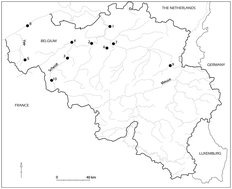Carbon and nitrogen stable isotope ratio analysis of freshwater, brackish and marine fish from Belgian archaeological sites (1st and 2nd millennium AD)†
Abstract
Carbon and

- This article is part of the themed collection: Archaeometry
Maintenance work is planned for Wednesday 1st May 2024 from 9:00am to 11:00am (BST).
During this time, the performance of our website may be affected - searches may run slowly and some pages may be temporarily unavailable. If this happens, please try refreshing your web browser or try waiting two to three minutes before trying again.
We apologise for any inconvenience this might cause and thank you for your patience.
* Corresponding authors
a
Laboratory of Biodiversity and Evolutionary Genomics, Centre for Archaeological Sciences, University of Leuven, Ch. Debériotstraat 32, B-3000 Leuven, Belgium
E-mail:
ben_fuller@eva.mpg.de
b Department of Human Evolution, Max Planck Institute for Evolutionary Anthropology, Deutscher Platz 6, D-04103 Leipzig, Germany
c Department of Archaeology, University of Reading, Whiteknights P.O. Box 227, Reading RG6 6AD, UK
d Royal Belgian Institute of Natural Sciences, Vautierstraat 29, B-1000 Brussels, Belgium
e Flanders Heritage, Koning Albert II-laan 19, box 5, B-1210 Brussels, Belgium
f Department of Anthropology, University of British Columbia, Vancouver, British Columbia V6T 1Z1, Canada
Carbon and

 Please wait while we load your content...
Something went wrong. Try again?
Please wait while we load your content...
Something went wrong. Try again?
B. T. Fuller, G. Müldner, W. Van Neer, A. Ervynck and M. P. Richards, J. Anal. At. Spectrom., 2012, 27, 807 DOI: 10.1039/C2JA10366D
To request permission to reproduce material from this article, please go to the Copyright Clearance Center request page.
If you are an author contributing to an RSC publication, you do not need to request permission provided correct acknowledgement is given.
If you are the author of this article, you do not need to request permission to reproduce figures and diagrams provided correct acknowledgement is given. If you want to reproduce the whole article in a third-party publication (excluding your thesis/dissertation for which permission is not required) please go to the Copyright Clearance Center request page.
Read more about how to correctly acknowledge RSC content.
 Fetching data from CrossRef.
Fetching data from CrossRef.
This may take some time to load.
Loading related content
